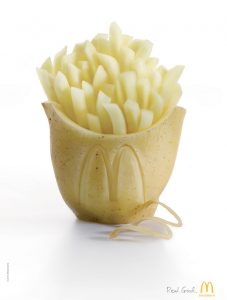Original Ad:

Image Source:
http://www.creativebloq.com/inspiration/print-ads-1233780
(image url) http://cdn.mos.cms.futurecdn.net/8550d87b32db3ecbf893418b3dee5d8a.jpg
McDonald’s is a fast-food restaurant with franchises across the globe. It originated in 1940 in the United States. Since then, beyond the signature items on the menu, there have been items added and taken away according to societal trends. Most recent, additional ‘healthy’ items have been added.
I chose this ad to analyze as it shows one of the signature menu items, French fries, spun for marketing to encourage the viewer to see it as a ‘healthy’ choice. This ad is deceptively simple. It is a potato, carved to look like a container of French fries. The only words, besides the branding, are “Real. Good.” The consumer is drawn to this picture of a natural ingredient by the plain white background. The focus is on the ‘real’ food. The viewer does not have to be able to read English to understand the message that McDonald’s French fries are made from real potatoes.
McDonald’s French fries are lambasted as caloric nightmares cooked in oil that solidifies upon cooling and clogs digestive tracks and arteries alike. If you look at the calorie and sodium count (as printed on the side of the French fry container) this item is one of the worst food choices on the McDonald’s menu per gram serving.
Mainstream media and trends have leaned toward clean eating, whole foods and natural foods in the past couple of years. Fast-food has a reputation for being unhealthy and a poor choice. Busy parents feel guilty for choosing McDonald’s as a quick, on-the-go dinner choice for their child. Low income parents feel guilty that fast-food might be the only thing they can afford to feed their child. With this ad, consumers are buying into the idea that because French fries are made from natural ingredients, they are a healthy choice. In consumer ethics, what a person buys is reflective of their reasoning for making the purchase in the first place. What better way to ease the guilt of the fast-food consumer than to convince them that what they are buying is actually natural and therefore must be all right and good for them.
Jammed Ad:

In jamming this ad, I have attempted to show the reality of the product versus the spin-factor marketing that has taken place. It is not just potatoes that go into McDonald’s fries. There are a whole slew of other ingredients, some obviously not of natural origin. The absurdity of this McDonald’s marketing scheme is that it could convince the unknowing, uniformed consumer that the product they are buying is real and therefore must be healthy.
In the jammed version, I have added the entire list of ingredients from the Canadian menu (there are other ingredients added to French fries produced for the American market). This list is directly from the McDonald’s Food Facts brochure. I have also added a disclaimer, like those you see in the small print at the bottom of a pharmaceutical advertisement. This is to remind the consumers that what may come from a healthy ingredient may not be healthy for them after the producing, preserving and cooking processes have occurred. I have also tweaked the tagline “Real. Good.” to state “Not. Real. Good.”
With the modifications I have made to the original ad, I have hoped to increase consumer awareness of what they are really buying into. They are not buying a healthy product. They are buying a modification of a healthy ingredient.
References:
Chai, Carmen. “Here are the 19 ingredients that go into McDonald’s French fries”. Global News. As retrieved from http://globalnews.ca/news/1789231/here-are-the-19-ingredients-that-go-into-mcdonalds-french-fries/
McDonald’s Food Facts. As retrieved from http://www1.mcdonalds.ca/NutritionCalculator/IngredientFactsEN.pdf
